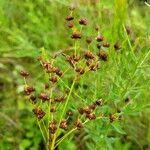Herbs, perennial, occasionally tufted, sometimes rhizomatous, 3--13 dm. Rhizomes short, knotty. Culms compressed. Leaves basal and cauline; auricles 0.5--1.5 mm, apex rounded, membranous; basal blade flat, 20--4.5 dcm x 1.5--5 mm, cauline reduced. Inflorescences glomerules, (2--)5--200, each with (1--)2--10(--20) flowers, mostly open, 3--10(--15) cm; primary bract shorter than inflorescence. Flowers: tepals dark brownish, usually with green midstripe, outer series ovate-lanceolate, 1.8--3.2 mm, margins broad, clear, awned or not, apex acutish; inner series ovate to lanceolate, 2--3.5 mm, slightly longer than outer series, apex obtuse to acute, awned or not; stamens 3, opposite outer tepals, shorter to longer than tepals, filaments 1.1--2.5 mm, anthers 0.3--1.2 mm; style 0.3 mm. Capsules brown and sometimes dark spotted, 3-locular, obovoid to nearly globose, 1.8--2.9 mm, shorter to longer than perianth. Seeds yellow to light brown, fusiform, 0.4--0.7 mm, not tailed. 2n = 38, 40.
More
Stems cespitose, bulbous-thickened at base, 2–5 dm, seldom taller; lf-sheaths with rounded scarious auricles; principal blades 1–3 mm wide, with 3 prominent veins; invol lf shorter to somewhat longer than the infl; heads 5–20, 4–6 mm thick, subtended by lance-attenuate bracts; fls eprophyllate; sep lanceolate, 2.1–3.1 mm, acuminate or short-aristate; pet 2.3–3.3 mm, oblong with broadly scarious margins, obtuse or rounded; stamens 3, nearly as long as the tep, the anthers reddish-brown, much shorter than the filaments, usually soon shriveling; fr incompletely 3-locular (the partitions not meeting in the center), somewhat turgid-inflated, broadly obovoid, 1.8–2.9 mm, nearly or quite as thick, broadly rounded or somewhat retuse at the tip; 2n=38, 40. Wet meadows and swales; N.S. to Minn. and S.D., s. to Fla. and Tex.


